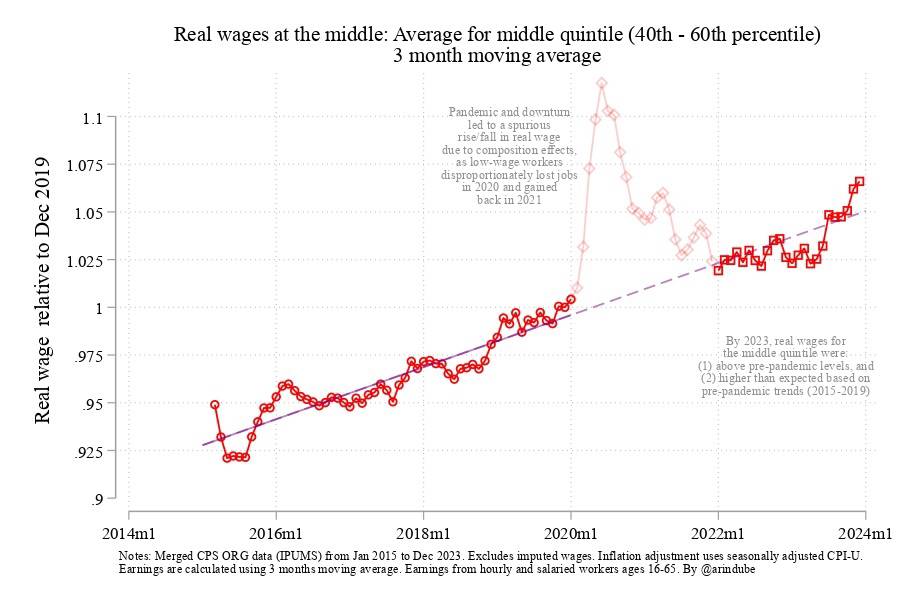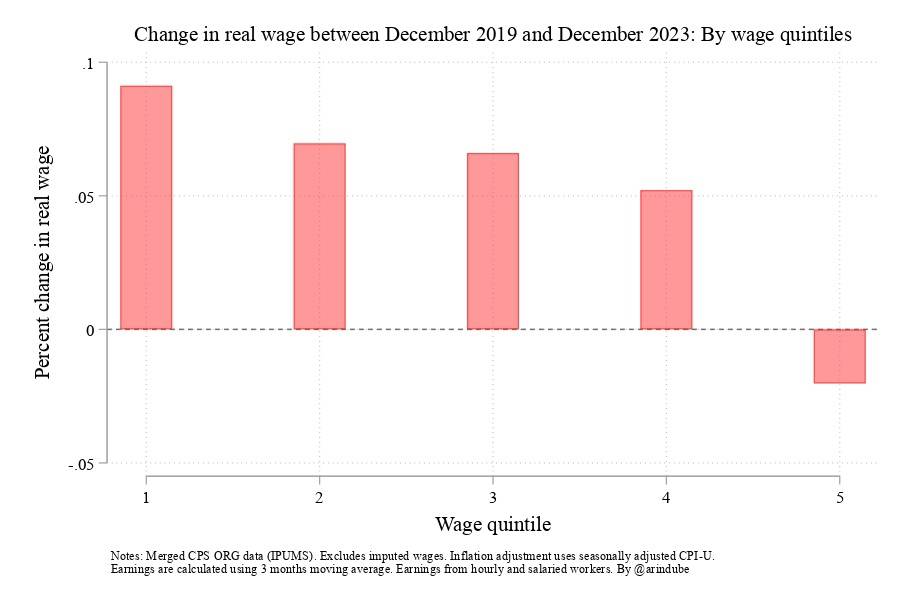Originally published at Project-Syndicate | Feb 8th, 2024
After five decades of widening inequality and stagnant pay, low- and middle-income workers in the United States experienced a significant increase in real wages over the past four years. This is a direct result of macroeconomic policies designed to create an exceptionally tight labor market.
AMHERST – Amid global inflationary pressures and geopolitical turmoil, the American job market is experiencing a major transformation: real wages, especially for low- and middle-income earners, are growing robustly. This trend marks a radical departure from decades of widening inequality and stagnant wages, defying the prevailing narrative of economic pessimism. Instead, it reflects a dynamic job market, powered by effective policies aimed at healing the wounds of the COVID-19 pandemic and subsequent economic shocks.
The evidence is compelling. In a recent study I co-authored with David Autor and Annie McGrew, we show that wage growth for most American workers has outpaced the spike in the cost of living since the beginning of the pandemic. Updated data show that in the middle pay range, between the 40th and 60th percentiles, inflation-adjusted wages in December 2023 were 3.9% higher than in December 2022, and 6.6% higher than in December 2019. Similar real wage gains can also be observed in establishment data.

Importantly, the real wages of the middle quintile are not only higher today than they were before the pandemic, but slightly higher than we would expect based on 2015-19 trends. In other words, the typical American worker’s purchasing power has grown at least as much as it likely would have in the absence of the global challenges posed by the pandemic and geopolitical conflicts.
To measure US wage growth during the pandemic, it is essential to consider the so-called composition effect. In 2020 and 2021, average wage changes were driven more by workforce shifts than by increases in actual compensation. While the loss of low-paying jobs initially inflated the average wage, this issue had largely been resolved by 2022 as employment rates returned to normal levels, allowing for accurate comparisons. Therefore, it is more useful to compare 2022-23 wages to the pre-pandemic period than to 2021.
If we do want to compare current wages to those from 2021, however, it is more instructive to compare wages for the same individuals over time. Here, we observe that for earners in the middle quintile, real wage growth during 2021-22 was somewhat constrained due to inflation, with a mean annual change of 1.2% and a median change of -1.1%. But the situation has improved significantly over the past year, with a mean change of 3.3% and a median change of 1.3%. Crucially, however, due to data limitations, these measures miss much of the wage gains experienced by individuals re-entering the labor market over this period, and therefore understate the overall increase in wages across the US economy.
Remarkably, the most significant wage growth occurred at the lower end of the pay scale. Just prior to the pandemic, the bottom quintile experienced a 9% increase in real wages, compared to 5-7% for the next three quintiles, while prices have increased faster than wages for those in the top 20% of the income distribution. This shift in wage growth toward lower- and middle-wage earners has helped address longstanding disparities, as wage increases over the past 50 years have disproportionately benefited top earners.
The surge in wages for low- and middle-wage workers can be attributed to an extraordinarily tight labor market, fueled by what has come to be known as the “Great Reshuffle.” With an abundance of job openings and fierce competition for talent, increased labor market competition empowered workers to leave bad jobs for better ones. The reallocation of American workers to better-paying jobs played a key role in narrowing the disparity between low- and high-wage earners, likely leading to an increase in productivity. This contrasts with the aftermath of the Great Recession, when such reallocation broke down as we failed to provide sufficient fiscal support.

Moreover, these pay gains helped mitigate some of the increase in inequality that affected low- and middle-income workers over the past four decades, erasing nearly 40% of the rise in the wage gap between the 90th and 10th percentiles during that period. Notably, wages for Black workers rose sharply compared to their white counterparts, reversing a four-decade trend. And when we compare wage growth for the same individuals, even during the burst of inflation in 2021 and 2022, the mean growth in real wages for workers in the bottom three quintiles was 6.8%, and the median was 1.2%. Real wages grew for most middle- and low-wage workers even during the height of inflation.
But the wage boom was not inevitable. In fact, the US is the only G7 country that experienced substantial real wage gains in recent years. While American workers’ wages have increased by 2.8% since late 2019, workers in other major economies have faced stagnant or even negative wage growth, ranging from a 0.2% increase in Canada to a 9% decline in Italy.
America’s positive wage trajectory is not a fluke, but rather a testament to the effectiveness of the proactive fiscal policies implemented during the pandemic, particularly US President Joe Biden’s American Rescue Plan. By focusing on healing the labor market, the US managed to bring back jobs, mitigate the devastating effects of the downturn, and generate sustained wage growth despite global price shocks (which fortunately are subsiding).
Indeed, our research shows that labor-market tightness played a pivotal role in ensuring that wage growth outpaced inflation. These findings point to the importance of policies aimed at enhancing tightness during this period and underscore the effectiveness of the administration’s macroeconomic approach. While some observers have been critical of the fiscal response championed by Biden, the resilience of the US labor market, with both jobs and wages rising even as inflation has fallen sharply, shows that the benefits of a swift labor market recovery have outweighed the costs.
To be sure, price inflation has had a more pronounced effect on low-income families than on their higher-income counterparts over the past four years. But even when accounting for these differences, it remains clear that lower-wage workers experienced a significantly greater increase in real pay.
While serious challenges persist, policies promoting full employment – such as those pursued by this administration – have been crucial in fostering wage growth and reducing pay disparities. As we approach the US presidential election in November, it is vital to acknowledge the economic policies that have revitalized the job market and improved workers’ wage prospects.
Some of the estimates and related data in this commentary are discussed here.
Arindrajit Dube: Professor of Economics at the University of Massachusetts Amherst, is a research associate at NBER, a research fellow at the Institute of Labor Economics, and a research affiliate at MIT’s Shaping the Future of Work Initiative.



